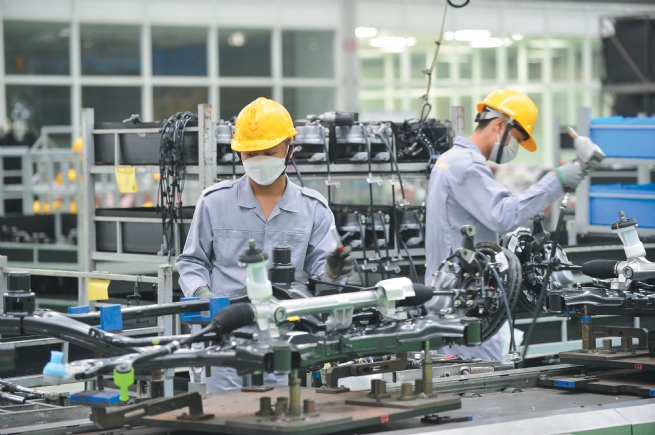9:43:47 AM | 12/13/2024
Over the past four decades, global integration has been the main driving force for Vietnam's remarkable development, fueling one of the most sustained and rapid periods of economic growth in modern history. Today, Vietnam ranks among the world's most open economies, with exports directly or indirectly contributing to approximately 50% of its GDP and employment.

Vietnam's export-led growth model faces a lot of challenges, including a shortage of highly skilled labor
Aiming for upper-middle-income status by 2030
Dr. Duong Trung Y, Deputy Director of the Ho Chi Minh National Academy of Politics, highlighted Vietnam's remarkable transformation over the past 40 years through the Doi Moi reforms. The country has shifted from a centrally planned, bureaucratically subsidized economy to a socialist-oriented market economy, driving rapid growth. Between 1986 and 2023, Vietnam achieved an average annual GDP growth rate of 6.5% (at constant prices), among the highest in the region. Real GDP per capita has surged nearly 45 times from US$96 in 1986 to approximately US$4,400 in 2023. Vietnam has also become a global exporter in key sectors such as textiles, footwear, furniture, electronics and agriculture. These achievements position Vietnam to attain upper-middle-income status by 2030.
Alongside its economic achievements, Vietnam's transformation has also improved social outcomes, lifting millions out of poverty. The multidimensional poverty rate dropped from over 60% in the late 1980s to below 6% in 2023, reflecting considerable progress in improving living standards and social well-being.
Past success does not guarantee future progress, and Vietnam's development journey is no exception. Dr. Duong Trung Y emphasized that achieving a high-income future will demand breakthrough, even landmark, policy and institutional reforms, including measures to ensure effective implementation. According to Manuela V. Ferro, World Bank Vice President for East Asia and the Pacific, global trade integration has been a major driver of Vietnam's progress, with GDP per capita rising to US$4,347 in 2023, averaging 5.1% annual growth. However, she said that attaining high-income status by 2045 will require Vietnam to accelerate its growth rate, supported by a comprehensive reform agenda to transform its growth model and capitalize on evolving global opportunities.
Promoting innovation
Building on its achievements, Vietnam has set an ambitious goal of becoming a modern, high-income economy by 2045. To achieve this, the country must sustain an annual GDP per capita growth rate of approximately 6% over the next two decades. Success hinges on advancing up the global value chain through robust investments in technology, skills, and innovation. However, this transition must be navigated amidst profound shifts in the global trade landscape, posing significant challenges to Vietnam’s economic strategy.
“To maintain rapid growth, Vietnam must transition from relying on labor-intensive, low-value-added final assembly to fostering higher-value-added manufacturing and services. Furthermore, in the face of changing global trade dynamics and rising uncertainties, diversifying trade and investment partnerships will be essential for building resilience and securing long-term success,” said Manuela V. Ferro.
A new World Bank report, "Vietnam 2045: Trading Up in a Changing World – Pathways to a High-Income Future," showed that Vietnam must triple its current per capita income to achieve high-income status by 2045. This goal requires sustaining an average GDP per capita growth rate of 6% over the next two decades. However, Vietnam’s export-led growth model faces major challenges, including a shortage of highly skilled labor, weak linkages between domestic and foreign enterprises, infrastructure constraints, and high carbon emissions in export-driven industries. Ms. Mariam Sherman, Country Director for Vietnam, Cambodia and Laos, stressed the need for Vietnam to shift its development and growth trajectory to escape the "middle-income trap." This transition will require comprehensive reforms, fostering innovation, and significantly improving labor productivity across industries and sectors.
Mariam Sherman emphasized the importance of fostering private sector participation and prioritizing education and skills development to build a workforce capable of driving technological adoption and facilitating the shift from low-value to high-value industries within the global value chain. These efforts are needed to enhance Vietnam’s economic position and competitiveness.
The World Bank outlined a comprehensive strategy to boost productivity, attract private sector investment, and strengthen Vietnam’s role in the global value chain. Key policy recommendations include deepening trade integration, strengthening linkages between domestic enterprises and global value chains, promoting high-tech and specialized skill-based industries, advancing high value-added service sectors, and transitioning to a low-carbon production model to address climate change challenges.
By Anh Mai, Vietnam Business Forum